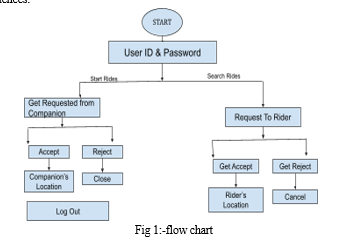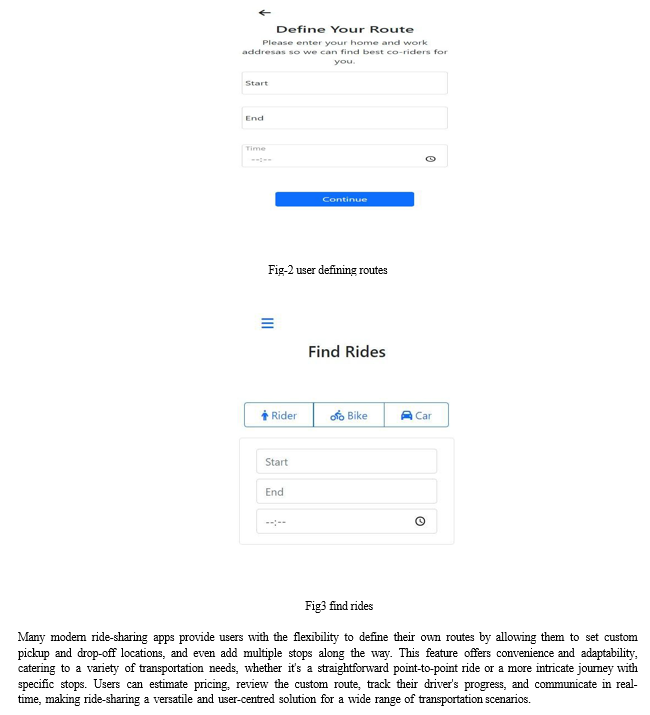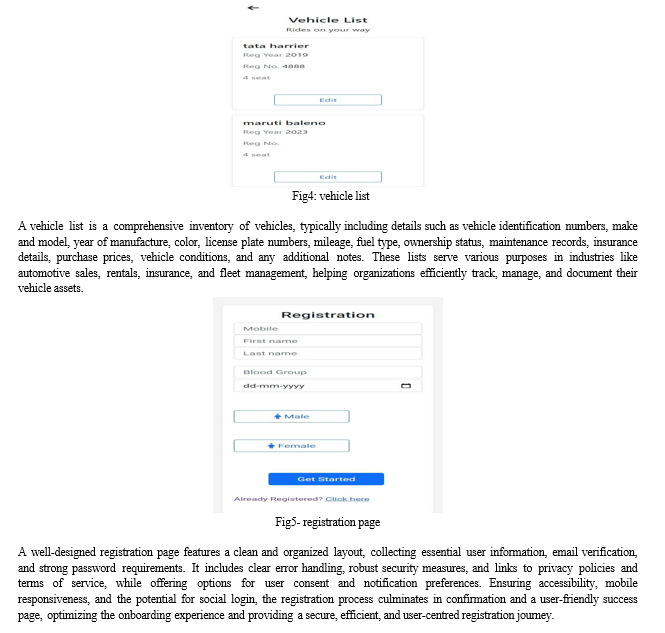Ijraset Journal For Research in Applied Science and Engineering Technology
- Home / Ijraset
- On This Page
- Abstract
- Introduction
- Conclusion
- References
- Copyright
RIDESHARE: An Innovative Way to Commute
Authors: Subodh Raibole, Utkarsh Dange, Vedant Pingle, Prathmesh Shegokar, Prof. Umesh S. Samarth
DOI Link: https://doi.org/10.22214/ijraset.2024.58876
Certificate: View Certificate
Abstract
In the face of escalating urban congestion, rising transportation costs, and mounting environmental concerns, the innovative concept of Ride Share is revolutionising the way people commute. This community-driven approach leverages technology, primarily through smartphone apps and web platforms, to facilitate the sharing of rides among individuals with similar destinations, effectively reducing the number of vehicles on the road. The key benefits of Ride Share include cost efficiency, as participants can significantly cut down on fuel and maintenance expenses, easing the financial burden of daily commuting. This also extends to reducing the demand for costly parking spaces, making it an economically appealing choice. Moreover, Ride Share\\\'s route optimization algorithms ensure efficient travel, further reducing time and costs. Beyond the economic advantages, this concept significantly contributes to environmental sustainability by alleviating traffic congestion and lowering greenhouse gas emissions. It aligns with the global push for greener transportation solutions and the fight against climate change. Ride Share represents a paradigm shift in daily transportation, fostering a sense of community and shared responsibility. As it continues to gain popularity, it promises to play a substantial role in creating a more efficient, cost-effective, and eco-friendly future for commuters worldwide.
Introduction
I. INTRODUCTION
In an age defined by the relentless growth of urban centres, increasing transportation expenses, and mounting environmental apprehensions, the innovative concept of Ride Share has emerged as a pivotal solution that is poised to revolutionise the way people commute. This introduction seeks to delve into the intricate details of Ride Share, providing a comprehensive understanding of its significance in addressing the multifaceted challenges posed by modern transportation. Urban congestion has become an undeniable hallmark of our times, with roads teeming with vehicles, leading to prolonged commutes, fuel wastage, and heightened stress levels. Simultaneously, the rising costs associated with owning and maintaining a private vehicle have placed significant financial burdens on individuals and families. These challenges are exacerbated by environmental concerns, particularly the pressing need to curtail greenhouse gas emissions and reduce our ecological footprint. RideShare, as a beacon of innovation, is redefining the way we approach our daily commutes. At its core, it's a community-driven initiative that encourages individuals to share rides with others who have similar destinations, a simple yet transformative concept. This concept is made accessible and practical through the power of technology, with smartphone apps and web platforms playing a central role in connecting commuters. These digital platforms offer user-friendly interfaces, making it easy for individuals to find and coordinate rides with fellow commuters, fostering a sense of shared responsibility and collaboration. While the convenience and cost-efficiency of RideShare are clear advantages, its implications extend beyond personal finance. Route optimization algorithms ensure that participants reach their destinations efficiently, saving both time and money. Moreover, Ride Share significantly contributes to environmental sustainability.
By reducing the number of vehicles on the road, it helps alleviate traffic congestion and, consequently, reduces greenhouse gas emissions, aligning with global efforts to promote greener transportation solutions and combat This introduction aims to provide a comprehensive overview of the pivotal role Ride Share plays in contemporary commuting, setting the stage for an in-depth exploration of its benefits, challenges, and potential for reshaping our transportation habits. It highlights the interconnected themes of cost efficiency, environmental responsibility, and community collaboration as fundamental pillars of Ride Share's success in addressing the intricate challenges of modern transportation. Through an understanding of this innovative concept, readers can gain insights into the transformative potential of Ride Share and its promise in creating a more efficient, cost-effective, and environmentally friendly future for commuters worldwide climate change.
II. LITERATURE SURVEY
- Ride sharing as a solution for urban congestion:numerous studies highlight the increasing problem of urban congestion in major cities worldwide. researchers have explored how ride-sharing services can help alleviate this issue by reducing the number of private vehicles on the road. they often cite case studies from cities like new york, london, and singapore to support this claim.
- Cost efficiency and savings:several academic papers and reports have analysed the cost-efficiency of ride-sharing compared to traditional private car ownership. they delve into how ride sharing can significantly reduce individual transportation costs by sharing expenses such as fuel, maintenance, and parking.
- Environmental benefits of ride sharing: Research in the literature underscores the potential environmental advantages of ride sharing by reducing the number of vehicles on the road, these services can lower greenhouse gas emissions and contribute to a more sustainable urban environment.
- Technological advancements and mobile apps: Many studies discuss the role of technology, particularly smartphone apps, in the rise of ride-sharing services. They explore how these platforms have made it easier for commuters to connect and arrange shared rides, emphasising their user-friendly interfaces and route opt.
- Challenges and Concerns: Researchers have also identified challenges associated with ride sharing, including regulatory issues, safety concerns, and the potential for increased traffic in certain situations. These studies often call for better regulation and safety measures in the ride-sharing industry.
- Social Impacts and Community Collaboration: Some academic works delve into the social aspects of ride sharing, focusing on how it promotes a sense of community and shared responsibility among participants. This communal approach has been associated with positive outcomes for both commuters and the environment. imization features.
- Future Research Directions: Many literature reviews and research articles conclude with suggestions for future research in the field of ride sharing. These might include exploring the long-term environmental impact, assessing the socioeconomic aspects, or investigating the potential for policy changes to support ride-sharing initiatives.
III. METHODOLOGY
The Lift Rewards Android application is an innovative solution addressing cost-efficient and eco-friendly transportation challenges. It promotes ride-sharing to reduce costs and ecological footprints. Using mobile technology, it connects ride providers and seekers, encouraging eco-conscious behavior through a points-based reward system. Key features include a user-friendly interface, route optimization algorithms, and a comprehensive point-earning system.
This gamified approach fosters social responsibility, reducing traffic congestion and greenhouse gas emissions while making transportation more accessible.
In summary, Lift Rewards is a forward-thinking solution promoting greener and cost-effective transportation, addressing traffic congestion and environmental sustainability while fostering inclusivity and eco-consciousness.
- User Registration and Profiles: A well-designed registration page features a clean and organized layout, collecting essential user information, email verification, and strong password requirements. It includes clear error handling, robust security measures, and links to privacy policies and terms of service, while offering options for user consent and notification preferences. Ensuring accessibility, mobile responsiveness, and the potential for social login, the registration process culminates in confirmation and a user-friendly success page, optimizing the onboarding experience and providing a secure, efficient, and user-centered registration journey.
- Adding Route: Adding a route in a navigation or mapping application involves specifying a starting point and a destination, setting route preferences, reviewing the suggested route, and initiating navigation. During the journey, the app provides real-time guidance and may offer options for custom waypoints or alternative routes to enhance the travel experience.
- Vehicle List Database: A vehicle list is a comprehensive inventory of vehicles, typically including details such as vehicle identification numbers, make and model, year of manufacture, color, license plate numbers, mileage, fuel type, ownership status, maintenance records, insurance details, purchase prices, vehicle conditions, and any additional notes. These lists serve various purposes in industries like automotive sales, rentals, insurance, and fleet management, helping organizations efficiently track, manage, and document their vehicle assets.
- Real-time Assistance: Finding rides in the context of ride-sharing or carpooling typically involves using a dedicated mobile application to locate available drivers who can transport you to your desired destination. To find a ride, users open the app, enter their current location and destination, and the app presents a list of nearby drivers along with estimated arrival times and prices. Users can then choose a driver, request a ride, and track the driver's location in real-time. The app streamlines the process of finding rides, making it convenient, efficient, and often more cost-effective than traditional transportation methods.
- Location-Based Search: The system enables users to search for mechanics based on their current location or nearby areas. This functionality is particularly valuable in remote locations where access to traditional repair services may be limited.
- User Security and Data Privacy: Robust data security measures are implemented to protect user information and maintain the confidentiality of personal and vehicle-related data. Users can trust the system to safeguard their privacy.Location-based search, also known as geospatial search, is a process of retrieving information or services based on a specific geographic location or proximity to a user's current position. This type of search is commonly used in various applications and services to provide users with location-specific results.
- User Feedback Mechanism: A user feedback mechanism is a structured system that enables users to share their comments, suggestions, and criticisms about a product or service through various accessible channels. This mechanism includes categorizing feedback, acknowledging and analyzing user input, responding to user concerns, maintaining privacy and security standards, and using the insights for iterative product or service improvement, ultimately fostering user engagement, trust, and enhanced user experiences.

IV. EXPERIMENTAL RESULTS
Ride sharing, also known as carpooling or ridesharing, is a transportation arrangement in which multiple individuals share a single vehicle to travel from one location to another. This practice is typically facilitated by various methods, including ride-sharing apps, informal agreements among friends or coworkers, or organised ridesharing programs. Ride sharing offers several advantages, including: Cost Savings- Sharing the cost of fuel, maintenance, and tolls can significantly reduce the financial burden of transportation for all participants. Reduced Congestion: By reducing the number of vehicles on the road, ride sharing can alleviate traffic congestion, resulting in shorter commute times and decreased stress. Environmental Benefits Fewer vehicles on the road mean lower greenhouse gas emissions and a reduced carbon footprint, contributing to environmental sustainability. Social Interaction Carpooling often provides an opportunity for social interaction during the commute, promoting a sense of community and shared responsibility.
Reduced Parking Costs With fewer cars on the road, there is less demand for parking spaces, which can lead to cost savings for participants. Access to Transportation: Ride sharing can provide transportation options to those who may not have access to a private vehicle, making it more inclusive and accessible. Ride-sharing services, often facilitated through dedicated mobile apps, have gained significant popularity in recent years. Companies like Uber, Lyft, and ola have created platforms that connect drivers with passengers looking to share rides. These services have not only transformed the way people commute but have also had a significant impact on the transportation industry, changing the way we think about car ownership and mobility.


Conclusion
The Lift Rewards Android application stands as an innovative and transformative solution to the pressing challenges of cost-efficient and eco-friendly transportation in our contemporary world. It tackles the issues of urban congestion, escalating transportation costs, and mounting environmental concerns head-on, offering a promising path towards a more sustainable and responsible future of commuting. Throughout our exploration of the Lift Rewards application, we have unveiled its key features and benefits, shedding light on how it has the potential to reshape our approach to transportation. With a user-friendly interface, route optimization algorithms, and a comprehensive point-earning system, it has positioned itself as a pioneering force in the realm of eco-conscious and cost-effective travel. What sets Lift Rewards apart is its ingenious gamified approach. By encouraging users to participate in the sharing of rides, it promotes a sense of social responsibility and community engagement. This not only translates to reduced traffic congestion and lower greenhouse gas emissions but also serves to make transportation more accessible and affordable for those in need, creating a more inclusive society in the process. In conclusion, Lift Rewards is more than just a solution; it is a vision for the future of transportation. It champions the cause of ride-sharing and green mobility, addressing the dual challenges of traffic congestion and environmental sustainability. As it continues to grow and expand, it has the potential to be a driving force behind a more efficient, cost-effective, and eco-conscious commuting landscape. The future of transportation is indeed promising with the presence of initiatives like Lift Rewards, poised to redefine the way we move and live.
References
[1] Aei (2022). The Dark Side of the Metaverse, Part1. Accessed on 24.04.2022. https://www.aei.org/technology-and-innovation/the-dark [2] Google Scholar Aichner and Gruber, 2017 T. Aichner, B. Gruber Managing customer touchpoints and customer satisfaction in B2B mass customization: A case study International Journal of Industrial Engineering and Management, 8 (3) (2017), pp. 131-140 View article CrossRefView in ScopusGoogle Scholar [3] Alaimo and Kallinikos, 2017 C. Alaimo, J. Kallinikos Computing the everyday: Social media as data platforms The Information Society, 33 (4) (2017), pp. 175-191 View article CrossRefView in ScopusGoogle Scholar Alspach, 2022 [4] Alspach, K. (2022) Why the fate of the metaverse could hang on its security https://venturebeat.com/2022/01/26/why-the-fate-of-the-metaverse-could-hang-on-its-security/ 26 January. [5] Google Scholar Amazon Web Services, 2015 Amazon Web Services (2015), Introduction to AWS Security by Design,?https://reciprocity.com/resources/what-is-security-by-de sign/?. [6] Google Scholar Amorim et al., 2014 T. Amorim, L. Tapparo, N. Marranghello, A.C. Silva, A.S. Pereira A multiple intelligences theory-based 3D virtual lab environment for digital systems teaching Procedia Computer Science, 29 (2014), pp. 1413-1422 View PDFView articleView in Scopus [7] Google Scholar Aydo?an, 2021 D. Aydo?an Art exhibitions during the pandemic Communication and Technology Congress – CTC, 2021 (2021), pp. 49-55 View article CrossRefGoogle Scholar Baar, 2021 [8] Baar, A. (2021). Marriott reveals NFTs as brand readies extended stay in metaverse. ? https://www.marketingdive.com/news/marriott-reveals- nfts-as-brand-readies-extended-stay-in-metaverse/61108 0/. [9] Google Scholar Badilla Quintana and Fernández, 2015 M.C. Badilla Quintana, S.M. Fernández A pedagogical model to develop teaching skills. The collaborative learning experience in the Immersive Virtual World TYMMI Computers in Human Behavior, 51B (2015), pp. 594-603 View PDFView articleView in Scopus [10] Google Scholar Bakker et al., 2016 R. Bakker, R. DeFillippi, A. Schwab, J. Sydow Temporary organizing: Promises, processes, problems Organization Studies (2016), pp. 1-17, 10.1177/0170840616655982 View article [11] Google Scholar Balcik et al., 2010 B. Balcik, B.M. Beamon, C.C. Krejci, K.M. Muramatsu, M. Ramirez Coordination in humanitarian relief chains: Practices, challenges and opportunities International Journal of production economics, 126 (1) (2010), pp. 22-34 View PDFView articleView in Scopus [12] Google Scholar Balis, 2022 J. Balis How brands can enter the metaverse HBR Online (2022), pp. 1-6 Google Scholar Ball, 2020 Ball, M. (2020, January 13). The metaverse: What it is, where to find it, and who will build it. MatthewBall.Vc. https://www.matthewball.vc/all/themetaverse. [13] Google Scholar Bardhi and Eckhardt, 2017 F. Bardhi, G.M. Eckhardt Liquid consumption Journal of Consumer Research, 44 (3) (2017), pp. 582-597 View article CrossRefView in ScopusGoogle Scholar Barreto, 2013 A.M. Barreto Do users look at banner ads on Facebook? Journal of Research in Interactive Marketing, 7 (2) (2013), pp. 119-139 View in Scopus [14] Google Scholar Barry et al., 2015 D.M. Barry, N. Ogawa, A. Dharmawansa, H. Kanematsu, Y. Fukumura, T. Shirai, K. Yajima, …, T. Kobayashi Evaluation for Students’ Learning Manner Using Eye Blinking System in Metaverse Procedia Computer Science, 60 (2015), pp. 1195-1204 View PDFView articleView in Scopus [15] Google Scholar Bauman, 2000 Z. Bauman Liquid Modernity Polity Press,, Cambridge (2000) Google Scholar Baxendale et al., 2015 S. Baxendale, E.K. Macdonald, H.N. Wilson The Impact of Different Touchpoints on Brand Consideration Journal of Retailing, 91 (2) (2015), pp. 235-253, 10.1016/j.jretai.2014.12.008 View PDFView articleView in ScopusGoogle Scholar [16] Belk, 2013 R. Belk Extended self in a digital world Journal of Consumer Research, 40 (3) (2013), pp. 477-500 View article CrossRefView in ScopusGoogle Scholar Bhattacherjee, 2001 A. Bhattacherjee Understanding information systems continuance: An expectation-confirmation model MIS Quarterly, 25 (3) (2001), pp. 351-370, 10.2307/3250921 View article View in ScopusGoogle Scholar [17] Biraghi et al., 2018 Biraghi, S., Gambetti, R. & Pace, S. (2018). Between tribes and markets: The emergence of a liquid consumer-entrepreneurship. Journal of Business Research. Elsevier. Google Scholar Bizouati-Kennedy, 2021 Bizouati-Kennedy, Y. (2021, December 1). The metaverse: What you should consider before investing in a virtual space. Yahoo. https://www.yahoo.com/video/metaverse-consider-inves ting-virtual-space-134452552.html. [18] Google Scholar Bloomberg, 2022 Bloomberg. (2022). Metaverse\\\'s $80 billion etf assets by 2024 virtually a reality Accessed 18.04.22.? https://www.bloomberg.com/professional/blog/metavers es-80-billion-etf-assets-by-2024-virtually-a-reality/?. [19] Google Scholar Bonifacic, 2021 Bonifacic, I. (2021) ‘Project Cambria’ is a high-end VR headset designed for Facebook’s metaverse https://techcrunch.com/2021/10/28/project-cambria-is-a-high-end-vr-headset-designed-for-facebooks-metaverse/ 28 October. [20] Google Scholar Bosworth, 2021 Bosworth, A. (2021, November 15). Building the metaverse responsibly. Meta. https://about.fb.com/news/2021/09/building-the-metave rse-responsibly/. [21] Google Scholar Bourlakis et al., 2009 M. Bourlakis, S. Papagiannidis, F. Li Retail spatial evolution: Paving the way from traditional to metaverse retailing Electronic Commerce Research, 9 (1) (2009), pp. 135-148 View article CrossRefView in ScopusGoogle Scholar
Copyright
Copyright © 2024 Subodh Raibole, Utkarsh Dange, Vedant Pingle, Prathmesh Shegokar, Prof. Umesh S. Samarth. This is an open access article distributed under the Creative Commons Attribution License, which permits unrestricted use, distribution, and reproduction in any medium, provided the original work is properly cited.

Download Paper
Paper Id : IJRASET58876
Publish Date : 2024-03-08
ISSN : 2321-9653
Publisher Name : IJRASET
DOI Link : Click Here
 Submit Paper Online
Submit Paper Online

